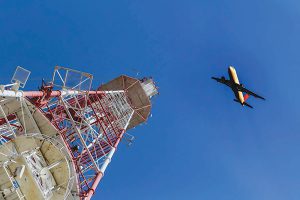Bloomberg
US safety regulators have received more than 100 pilot reports of possible inteference from 5G wireless signals —including three near Chicago O’Hare International Airport — since the new mobile phone service began.
The reports of anomalies on aircraft devices known as radar altimeters are being reviewed by the Federal Aviation Administration, said three people familiar with the matter who weren’t authorized to speak about it. Interference from the new 5G service has been ruled out in many of the cases, one of the people said, and it remains unclear whether the others indicate a safety hazard or just pilots being overly cautious.
“We are using our established safety-reporting systems to look into a handful of reports of possible 5G interference,†the FAA said in a statement. “So far none of these reports have been validated.â€
But the reports, combined with the vital role altimeters play in safety, help explain why the FAA has taken such a stringent approach to minimizing risks from the new wireless signals.
Radar altimeters that have malfunctioned in recent decades for reasons unrelated to mobile phone signals have been blamed for multiple accidents, including a crash near Amsterdam in 2009 that killed nine as well as several fatal helicopter crashes, a Bloomberg News review of US government and international records has found.
The malfunctions can create confusing cockpit alarms, said Jeff Guzzetti, an aviation safety consultant who formerly was head of accident investigations with the FAA. “Betting on whether or not the average pilot can resolve the situation is not a bet the FAA wants to make,†Guzzetti said.
New 5G mobile phone service introduced by AT&T Inc. and Verizon Communications Inc. operate on so-called C-band frequencies that are close to those used by radar altimeters, devices that normally provide highly accurate readings showing how far a plane is off the ground.
The wireless companies and the Federal Communications Commission have said that the dueling radio signals shouldn’t cause interference and research is underway to better understand how to limit risks.
Nick Ludlum, a spokesman for the wireless industry trade group CTIA, said it was important not to jump to “unsupported conclusions†about reports of interference. The group has repeatedly said there is no evidence that 5G can cause harmful interference on planes and notes other countries where it operates with no ill-effect on aviation, though in some cases at lower power levels and with restrictions.
The impact on aviation in the U.S. has so far been minimal as the FAA and wireless companies have agreed to at least temporarily restrict placement of cell towers near airports. But with wireless companies eager to activate hundreds more cell towers near airports and to expand into new frequency bands, the issue remains far from settled.
The FAA asked air crews to report any altimeter performance issues in a Nov. 2 bulletin. The reports have come in the form of radioed descriptions to air-traffic controllers as well as through more formal incident-reporting channels. The FAA often gathers unconfirmed reports of aviation incidents, such as drone sightings, even if they’re difficult to verify.
 The Gulf Time Newspaper One of the finest business newspapers in the UAE brought to you by our professional writers and editors.
The Gulf Time Newspaper One of the finest business newspapers in the UAE brought to you by our professional writers and editors.
